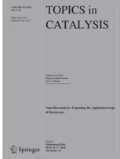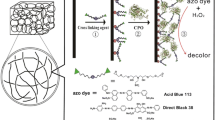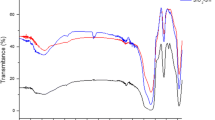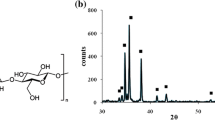Abstract
Chloroperoxidase (CPO) from Caldariomyces fumago is a versatile enzyme able to catalyze the styrene epoxidation. However, the lack of long-term operational stability is the principal drawback for the industrial applications of this enzyme. In this work, in order to increase the enzyme operational stability, CPO immobilization in TiO2 mesoporous materials was studied. Enzyme immobilization onto two TiO2 supports was assayed: microstructured TiO2 anatase (TiO2AN) and nanostructured TiO2 nanotubes (TiO2NT). The CPO/TiO2NT preparation showed 15-times higher catalytic activity for styrene epoxidation than the free enzyme, showing an excellent performance during the styrene epoxidation. In addition, the total turnover numbers for styrene epoxidation, for the free and immobilized enzyme were determined. The CPO immobilization in TiO2 materials increased the operational stability of CPO in 51 % in the case TiO2AN and 69 % for TiO2NT support. These results clearly show that CPO immobilization onto TiO2NT support significantly enhances the CPO enzymatic epoxidation of styrene.


Similar content being viewed by others
References
Allain EJ, Hager LP, Deng L, Jacobsen EN (1993) Highly enantioselective epoxidation of disubstituted alkenes with hydrogen peroxide catalyzed by chloroperoxidase. J Am Chem Soc 115(10):4415–4416
Lakner FJ, Hager LP (1996) Chloroperoxidase as enantioselective epoxidation catalyst: an efficient synthesis of (R)-(−)-mevalonolactone. J Org Chem 61(11):3923–3925
Hager LP, Lakner FJ, Basavapathruni A (1998) Chiral synthons via chloroperoxidase catalysis. J Mol Catal B 5(1–4):95–101
Manoj KM, Lakner FJ, Hager LP (2000) Epoxidation of indene by chloroperoxidase. J Mol Catal B 9(1–3):107–111
Ayala M, Batista C, Vazquez-Duhalt R (2011) Heme destruction, the main molecular event during the peroxide-mediated inactivation of chloroperoxidase from Caldariomyces fumago. J Biol Inorg Chem 16(1):63–68
Manoj KM, Hager LP (2001) Utilization of peroxide and its relevance in oxygen insertion reactions catalyzed by chloroperoxidase. Biochim Biophys Acta 1547(2):408–417
Sun W, Kadima TA, Pickard MA, Dunford HB (1994) Catalase activity of chloroperoxidase and its interaction with peroxidase activity. Biochem Cell Biol 72(7–8):321–331
Leak DJ, Sheldon RA, Woodley JM, Adlercreutz P (2009) Biocatalysts for selective introduction of oxygen. Biocatal Biotransform 27(1):1–26
Hou J, Dong G, Xiao B, Malassigne C, Chen V (2015) Preparation of titania based biocatalytic nanoparticles and membranes for CO2 conversion. J Mater Chem A 3(7):3332–3342
Arıca MY, Bayramoğlu G (2004) Polyethyleneimine-grafted poly(hydroxyethyl methacrylate-co-glycidyl methacrylate) membranes for reversible glucose oxidase immobilization. Bionchem Eng J 20(1):73–77
Rekuć A, Bryjak J, Szymańska K, Jarzębski AB (2010) Very stable silica-gel-bound laccase biocatalysts for the selective oxidation in continuous systems. Bioresour Technol 101(7):2076–2083
Águila S, Vazquez-Duhalt R, Covarrubias C, Pecchi G, Alderete JB (2011) Enhancing oxidation activity and stability of iso-1-cytochrome c and chloroperoxidase by immobilization in nanostructured supports. J Mol Catal B 70(3–4):81–87
Aguila S, Vazquez-Duhalt R, Tinoco R, Rivera M, Pecchi G, Alderete JB (2008) Stereoselective oxidation of R-(+)-limonene by chloroperoxidase from Caldariomyces fumago. Green Chem 10(6):647–653
Wu L, Li F, Xu Y, Zhang JW, Zhang D, Li G, Li H (2015) Plasmon-induced photoelectrocatalytic activity of Au nanoparticles enhanced TiO2 nanotube arrays electrodes for environmental remediation. Appl Catal B 164:217–224
Mor GK, Varghese OK, Paulose M, Shankar K, Grimes CA (2006) A review on highly ordered, vertically oriented TiO2 nanotube arrays: fabrication, material properties, and solar energy applications. Sol Energy Mater Sol C 90(14):2011–2075
Muñoz-Guerrero FA, Águila S, Vazquez-Duhaltb R, Alderete JB (2015) Enhancement of operational stability of chloroperoxidase from Caldariomyces fumago by immobilization onto mesoporous supports and the use of co-solvents. J Mol Catal B 116:1–8
Pickard M, Kadima T, Carmichael R (1991) Chloroperoxidase, a peroxidase with potential. J Ind Microbiol 7(4):235–241
Maehly AC, Chance B (1954) The assay of catalases and peroxidases. In: methods biochemistry analysis, vol 357–424. Interscience Publishers, New York, pp 357–424
Hager LP, Morris DR, Brown FS, Eberwein H (1966) Chloroperoxidase: II. Utilization of halogen anions. J Biol Chem 241(8):1769–1777
Segel IH (1993) Enzyme kinetics: behavior and analysis of rapid equilibrium and steady-state enzyme systems. Wiley, New York
Sheldon RA, van Pelt S (2013) Enzyme immobilisation in biocatalysis: why, what and how. Chem Soc Rev 42(15):6223–6235
Sing KSW (1982) Reporting physisorption data for gas/solid systems with special reference to the determination of surface area and porosity. Pure Appl Chem 54:2201–2218
Dong Y, Gui Z, Hu Y, Wu Y, Jiang S (2012) The influence of titanate nanotube on the improved thermal properties and the smoke suppression in poly(methyl methacrylate). J Hazard Mater 209–210:34–39
Hallenberg PF, Hager LP (1978) Purification of chloroperoxidase from Caldariomyces fumago. Methods Enzymol 52:521–529
Aburto J, Ayala M, Bustos-Jaimes I, Montiel C, Terrés E, Domínguez JM, Torres E (2005) Stability and catalytic properties of chloroperoxidase immobilized on SBA-16 mesoporous materials. Microporous Mesoporous Mater 83(1–3):193–200
Illanes A (2008) Enzyme biocatalysis. Springer, New York
Jung D, Paradiso M, Wallacher D, Brandt A, Hartmann M (2009) Formation of cross-linked chloroperoxidase aggregates in the pores of mesocellular foams: characterization by SANS and catalytic properties. Chem Sus Chem 2(2):161–164
Van Deurzen MPJ, Seelbach K, van Rantwijk F, Kragl U, Sheldon RA (1997) Chloroperoxidase: use of a hydrogen peroxide-stat for controlling reactions and improving enzyme performance. Biocatal Biotransform 15(1):1–16
Seelbach K, van Deurzen MPJ, van Rantwijk F, Sheldon RA, Kragl U (1997) Improvement of the total turnover number and space-time yield for chloroperoxidase catalyzed oxidation. Biotechnol Bioeng 55(2):283–288
Thomas JA, Morris DR, Hager LP (1970) Chloroperoxidase: VII. Classical peroxidatic, catalityc, and halogenating forms of the enzyme. J Biol Inorg Chem 245(12):3129–3134
Mozhaev VV, Melik-Nubarov NS (1990) Biocatalysis 3:179–187
Valderrama B, Ayala M, Vazquez-Duhalt R (2002) Suicide inactivation of peroxidases and the challenge of engineering more robust enzymes. Chem Biol 9:555–565
Vazquez-Duhalt R, Semple KM, Westlake DWS, Fedorak PM (1993) Effect of water-miscible organic solvents on the catalytic activity of cytochrome c. Enzyme Microb Technol 15(11):936–943
Park J-B, Clark DS (2006) Deactivation mechanisms of chloroperoxidase during biotransformations. Biotechnol Bioeng 93(6):1190–1195
Acknowledgments
F. A. Muñoz-Guerrero thanks to CONICYT for a graduate fellowship (Folio 63105502). Authors are grateful for the support of Conacyt-Conicyt International Cooperation Program (Folio PCCI130043) between México and Chile governments. REDOC CTA (Universidad de Concepción).
Author information
Authors and Affiliations
Corresponding author
Rights and permissions
About this article
Cite this article
Muñoz-Guerrero, F.A., Águila, S., Vazquez-Duhalt, R. et al. Biocatalytic Performance of Chloroperoxidase from Caldariomyces fumago Immobilized onto TiO2 Based Supports. Top Catal 59, 387–393 (2016). https://doi.org/10.1007/s11244-015-0438-1
Published:
Issue Date:
DOI: https://doi.org/10.1007/s11244-015-0438-1




